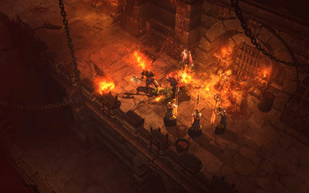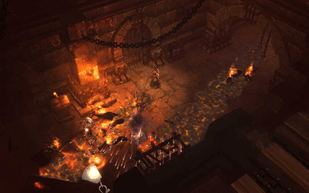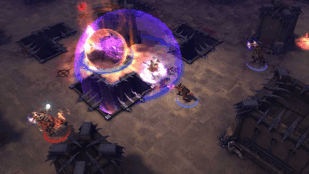- Joined
- Jul 9, 2008
- Messages
- 2,555
The original post can be found here.
Soulskill on Slashdot said:At this year's Blizzcon, we got to try out a section of Diablo 3 that was pulled directly from the single-player storyline and playable with all classes. A large number of skills and abilities were playable, and the skill rune system has been implemented, a feature that was lacking for last year's demo build. We also got to spend some time trying out the newly announced PvP system — Battle Arenas. Read on for a walk-through of Diablo 3 as we've seen it so far. In short: it's shaping up to be an excellent game, and a worthy successor to Diablo 2.
The demo started me off at with a level 9 character and dropped me into a dungeon, offering up two objectives: fight my way through and, as a bonus, find and destroy a particular boss. From the start, it had a very familiar feel. I took a few steps down the hall and got rushed by a group of monsters, which I quickly mowed down by mashing the buttons on my mouse. It's Diablo, alright. Here I paused to actually read my abilities and see how the UI worked. If you've followed along with the game's development at all, you're probably aware of the fact that the Diablo 2 potion belt is gone. The 1-5 keys are now used to activate skills displayed on an action bar at the bottom of the screen. The right and left mouse buttons also activate skills (ostensibly the most-used ones), and pressing tab will swap back and forth between two skills bound to the right mouse button. Subtract one of those slots for health potions and you've got seven easily-accessible skills.
Skills:

Of course, I didn't get that many to start; instead, they're doled out as a character levels up, increasing the complexity of combat slowly but steadily. Blizzard has done away with the talent-trees of old, so picking skills is a lot tougher. Instead, every few levels a new skill slot unlocks, and you get to pick an actual activated ability that you'll immediately start using to kill monsters. On the levels in between the unlocks, you can power up one of your existing skills. All of the passive, math-y talents that were prevalent in Diablo 2 are dealt with through a different system, called Traits. Traits are a wide variety of passive bonuses that you get to spend points in every couple levels — things like boosting a particular stat, or increasing the amount of gold monsters drop. They're pretty straight-forward — not that exciting, but a nice, consistent way to make your character stronger in some way.
As it happens, attaining level 10 unlocks a skill slot (the fourth), so after spending a little time wading through the demonic hordes inhabiting the dungeon, I leveled up and tried to make a decision. It was pretty difficult to choose. There are a lot of fun-sounding or powerful-sounding skills, and you're just not able to get all of them. One of Blizzard's mantras of late has been about having the player make meaningful decisions, and this certainly qualified. They've stated in the past that some form of respec will be added to the game. They haven't ironed out the details, but they don't want it to be trivial. If I hadn't had a limited amount of time, I would have spent quite a while pondering which skill to take. It would have been nice to have some sort of preview, or a minute-long grace period to swap to something else. But it definitely created a feeling that there were more good options I'd be able to get in later levels.
I'll get to the individual classes and their skills in a moment, but one more feature that needs to be introduced is the Skill Rune system. This is a concept Blizzard has been playing with for a while, and last year it was in the midst of a redesign, so we didn't get to try it out. It works like this: each skill in your spellbook has one slot to which you can add a Skill Rune. The Rune then modifies how the skill works. It's somewhat similar to gem sockets in items. There are five different colors of runes, and each color will modify the skill in a different way. Runes have seven ranks, which modify how powerful the effect is. One example they talked about was the Wizard skill Magic Missile. Unaltered, it's just what it sounds like — launching an arcane projectile at a monster. With a rank 1 Indigo rune, the skill shoots an extra missile. With a rank 7 Indigo rune, it shoots seven extra missiles. I'll be blunt: Skill Runes are pretty awesome.
Classes:

The first class I tried out was the Witch Doctor. It's a caster class with voodoo- and necromancer-style magic. My main ranged attack was Poison Dart, which did some damage over time to monsters I hit. Adding a rune, it changed to a fire dart, which did more up-front damage at the expense of the DoT. I also had a skill that summoned pets to help me fight -- up to three Zombie Dogs at one time. They were actually powerful enough that I eventually let them die so I would have more to do. Runes affected them differently — one rune gave them a chance to drop a health orb when they died. Others modified how they did damage. The AI was pretty smart about having them attack the groups I wanted them to, and not go charging off on their own.
The skill I chose when I hit level 10 was Firebats. It functions similarly to the Inferno spell in Diablo 2, only instead of projecting a cone of flame in front of me, it projected a cone of flaming bats. The first Skill Rune I looked at extended the spell's range, trading off damage to do so. That was a bit underwhelming, since I already had ranged attacks, so I went with a different rune that turned the cone into a whirlwind of flaming bats that surrounded me. Another rune added a life-drain effect. It was tempting, but the whirlwind looked too cool to pass up. Finally, the skill that sold me on the Skill Rune system was Zombie Charger, a spell that summoned a zombie, who would shamble a few steps forward and then spray poison in the immediate vicinity. It was a solid, short-range attack. Fortunately, I lucked into a rune that modified the spell to summon a group of zombie bears that charged forward and trampled whatever was in their path. The buddy I was playing with happened to get a rune at the same time that made his Wizard's basic lightning spell change into a massive, conical spray of electricity, and we couldn't help but laugh as we used our new-found power to demolish groups of monsters.
The next class I tried was the recently revealed Demon Hunter. The class mixes ranges weapons with gadgets and dark magic for its offensive power. It bears similarities to both the Amazon and the Assassin from Diablo 2, but feels distinctly different to play. My main nuke, when I started out, was called Entangling Shot. It would do some damage and slow the monsters it hit, and then chain to other nearby monsters. Using Entangling Shot, it was quite easy to control entire groups of monsters. This was supplemented by a skill called Bola Shot, which would send a glowing bola out to wrap itself around the neck of a monster, exploding a few seconds later. It supplemented the slow effect of Entangling Shot nicely; by alternating between the two skills, I could drop big damage while keeping anything from reaching me. The Demon Hunter also had Vault, a movement skill that makes you leap forward through the shadows. It's a good way to get range — perhaps too good.

When I reached level 10, there were some interesting choices for new skills — a Fan of Knives provided area-of-effect damage in a circle around the Demon Hunter; Molten Arrow sends a blast of fire through monsters; Multi-Shot sends a conical rain of arrows that looks more like something out of 300 than the equivalent Amazon skill in Diablo 2. But I ended up choosing Grenades. The Demon Hunter tosses three grenades at the feet of her target, and they explode for huge damage. The cool thing about this skill is that you can bounce the grenades off walls, so you can blow up things around corners or in the back of a group that's rushing you. Unfortunately, I didn't get to try any runes with these skills. Overall, the Demon Hunter felt a lot more dynamic and... percussive than an Amazon.
I got a chance to tinker around with the Barbarian as well. This class uses a different resource system — fury is generated by certain attacks, and is then spent on other (generally more powerful) attacks. It certainly played differently than the range classes. Wading into groups and Cleaving away was standard operating procedure. I enjoyed this class less than the others, mainly due to the fact that fury generation seemed fairly slow, and my skills weren't that focused on damage. One ability, Revenge, was reactive, only becoming available occasionally during a pitched battle. At level 10, I picked up a skill that made him leap into a group of enemies, dealing damage when he landed. The trouble was that I didn't feel like I really had a go-to attack. I'd guess that this would be solved by different skill selection, but obviously the demo build had its limits.
Story, Lore, Art:
The story is handled in two ways: Lore tomes and quests. The tomes are actual loot objects that drop at certain places in the zone. When you pick them up, a voice-over starts that explains a bit about whatever is going on. It comes with a handy little UI box that lets you pause, play, or cancel the recording. The quests we saw were mostly linear. As mentioned earlier, the goal during the fire dungeon was to simply fight our way through, killing a particular boss on the way. Once we got out, we stepped outside into a new zone, and there was a quest available immediately to help the quest-giver track somebody down and take him out. Successfully doing so turned the quest-giver into a vendor for magical weapons.

This outdoor area was short, but led to another dungeon, this time an eerie-looking jail-tomb combination. Another new quest sent us searching through many small cells in an effort to free the souls of the innocently imprisoned. It was a fairly big dungeon, but the quest objectives were easy to find — when you got close to them, there was a glowing circle on the ground that made them easy to see. Once done with that, to escape the prison you needed a key that dropped from the zone's boss. A helpful marker on the map pointed out where he was — the convergence of four high walkways, with deep pits below. As we reached the center, undead began swarming up the sides of the walkways out of the darkness below, surrounding and trapping us in place for when the boss popped out and started attacking. After defeating him and reaching the end of the zone, we got to see the end of the quest — a brief, brutal coda to the story we'd seen so far.
A brief word about the art. Diablo 3 is a visually dense game. There are a lot of things competing for your attention. Player skills get a bit of a priority, since that's what provides a feeling of interaction with the world, but there's always something cool to look at — monsters' spells, death animations, destructible objects that break apart violently, traps in the dungeon, and even just the scenery around you. The outdoor level we saw reminded me briefly of the art controversy that happened when Blizzard first showed off some of its level design. It's a cloudy, rainy environment, not terribly dark, but the colors are muted. When you first see it, it's less visually stimulating than the fiery dungeon you came out of, but soon you'll notice the rain, the billowing mist, the occasional lightning flash that makes colors suddenly pop out at you, and it just works.
PvP Battle Arenas:

I also got a chance to try out the new PvP arenas. I started off with doing some 2v2 as a Witch Doctor. The arena was roughly square-shaped, and small — perhaps a bit over two screen-widths wide. There are pillars placed around the map in ways that World of Warcraft PvPers will be familiar with. You can use them to break line-of-sight and gain a brief respite from a Wizard's Death-Star-inspired laser, or other attacks. Health orbs are sprinkled around the map, spawning periodically to let you regain some of your HP. As a Witch Doctor, I could send my Zombie Dogs off to harass my opponents, detonating them remotely to cause more substantial damage, supplementing them with firebombs and a damage-over-time spell.
The teamwork aspect of the fight made itself obvious immediately; at first I didn't pay attention to what my partner was doing, not recognizing when he was running away, and our two opponents turned and destroyed me. Once we started attacking and retreating in unison, letting my Zombie Dogs and his Hydras occupy key spots on the battlefield, we were able to keep the opposing Barbarian off of us long enough to deal with the other team individually.
Later, I did some 1v1 — a Wizard mirror match, which was a ton of fun. In addition to the aforementioned laser and Hydra spell, Wizards had Teleport (which is on a cooldown), Meteor, a damage absorption shield, and Slow Time, which drops a giant bubble around the Wizard, slowing any projectiles or enemies that are inside. With just these tools, we had some pretty complex, strategic fights for a couple of beginners. Dropping Hydras at strategic positions could cover a retreat or apply some damage on an opponent who ducked behind a pillar. Getting up close and using Slow Time gave an opportunity to drop a Meteor, which took several seconds to land but did massive damage. Even better, I'd pretend to retreat, and when he teleported to keep up with me, a Slow Time field or a Meteor would be there waiting for him. Out in the open, we traded laser barrages, but those never lasted long. The damage shield was on a cooldown, but combined with the health orbs it led to some surprisingly long matches that swung back and forth as we each grabbed temporary advantage. It was a lot of fun.
Misc. Tidbits:

A few neat but minor things caught my attention as I was playing through the game. We didn't get to see the crafting system, but we did have the ability to essentially disenchant items on the fly, which provide crafting materials. You do this by taking up to six items at a time from your inventory and dropping them in your cube, which breaks them apart. The UI is polished — there's not a lot of clicking involved — so it's a nice way to keep free space without ducking back to town every few minutes. The Talisman system is also convenient in that regard; it takes stat runes out of the inventory and puts them in their own storage space. Being able to see monster health bars is another quality-of-life change, as is the ability to resurrect your fallen teammates if you can get to them quickly enough (only works in PvE). The demo wasn't very difficult, but we didn't get to choose the difficulty setting, and I presume Blizzard didn't want people to spend their brief window of time making corpse runs.
Despite the new features and the major changes from a year ago, Diablo 3 really feels like a game, now. It seems like Blizzard has settled on most of the major decisions and is just ironing out the wrinkles while building the actual game content. Some systems, like Traits, still need some work, and it was hard to care about the items that dropped for a character we only got to play briefly. But I saw a lot of Blizzcon attendees finish their 15-minute play period and immediately get back in the 30-minute line. The PvP was entertaining, and hopefully Battle.net can provide good match-making while allowing small groups of friends to log on and battle each other whenever they feel like it. I usually try not to waste energy looking forward to a game that's still a ways off, but Blizzard's making it difficult.

